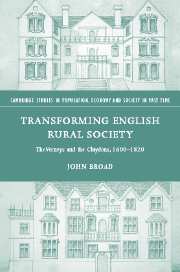Book contents
- Frontmatter
- Contents
- List of figures
- List of tables
- Preface
- Acknowledgements
- Note on editorial practice
- List of abbreviations
- 1 Introduction
- Part I Re-establishing a gentry family 1600–1657
- Part II The shaping of family and village 1657–1740
- 5 Land, business, and dynastic advance 1657–1736
- 6 The making of a modern landed estate
- 7 Power in the community – the making of an estate village 1660–1740
- Part III The great estate and estate communities c. 1700–1820
- Appendix A Sir Ralph Verney's confessional letter of 1650
- Appendix B The genealogy of the Verney family
- Bibliography
- Index
5 - Land, business, and dynastic advance 1657–1736
Published online by Cambridge University Press: 03 July 2009
- Frontmatter
- Contents
- List of figures
- List of tables
- Preface
- Acknowledgements
- Note on editorial practice
- List of abbreviations
- 1 Introduction
- Part I Re-establishing a gentry family 1600–1657
- Part II The shaping of family and village 1657–1740
- 5 Land, business, and dynastic advance 1657–1736
- 6 The making of a modern landed estate
- 7 Power in the community – the making of an estate village 1660–1740
- Part III The great estate and estate communities c. 1700–1820
- Appendix A Sir Ralph Verney's confessional letter of 1650
- Appendix B The genealogy of the Verney family
- Bibliography
- Index
Summary
Between the Restoration and the fall of Walpole, the Verney family successfully reversed the disasters of the Civil War period. Sir Ralph Verney outlived his eldest son and male grandchildren, so Claydon passed in 1696 to his second son John Verney, who had been apprenticed as a Levant merchant and made a respectable living from trade and finance before inheriting the estate. John married three times, raised the family to an Irish peerage, and was succeeded by his son Ralph who eventually became Earl Verney. In the eighty years spanned by this chapter the family remained an essentially middle-ranking gentry family, concerned with their estates, and with the social life of London. They participated in county politics as JPs and Deputy Lieutenants, and from 1680 to 1725 were often MPs. Their careers were worthy rather than outstanding, and they made no great fortunes from trade or office, and played no central role in government or at court. The family spent more time in London, where from the 1720s they had a permanent residence on the outskirts. Yet in 1736 they were considerably wealthier than they had been in 1657.
A sense of dynastic purpose, and a desire to make the Verneys financially strong dominated the outlook of successive heads of family. The disparate and uncertain seventeenth-century income sources were replaced by rental income from compact and improved estates, and money invested in a range of sound commercial enterprises and government bonds.
- Type
- Chapter
- Information
- Transforming English Rural SocietyThe Verneys and the Claydons, 1600–1820, pp. 83 - 111Publisher: Cambridge University PressPrint publication year: 2004



